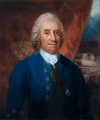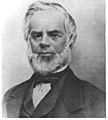History of New Thought facts for kids
New Thought is a spiritual movement that began in the 1830s. It started in both the United States and England. This movement is based on metaphysical ideas, which explore the basic nature of reality. New Thought has influenced many social changes from the 1800s until today. A famous thinker named William James once called New Thought "the religion of healthy-mindedness." He wrote this in his book The Varieties of Religious Experience.
Contents
What Inspired New Thought?
Early leaders of New Thought were interested in how metaphysics (the study of reality) connected with American Christianity. They also looked at something called "universal science."
Many other movements also started around the same time, in the late 1700s and early 1800s. These included Christian Science, the transcendental movement, and theosophy. They all shared similar ideas and interests.
One important idea came from transcendentalism. This belief says that true spirituality goes beyond the physical world. It can be understood through a person's own feelings and intuition, rather than just through traditional religion.
Key Figures Who Started New Thought
Before New Thought became a clear set of beliefs, some important people shared ideas that later became part of it.
Early Influencers
- Emanuel Swedenborg: He founded the 18th-century New Church. His writings greatly influenced how many New Thought authors understood the Bible.
- Ralph Waldo Emerson: His philosophical movement, transcendentalism, is a big part of New Thought ideas.
- Franz Mesmer: His work on hypnosis (sometimes called mesmerism) influenced Phineas P. Quimby. Quimby learned from Mesmer's ideas after hearing a lecture by Charles Poyen.
Phineas P. Quimby: The Founder
Phineas P. Quimby is often called the founder of the New Thought movement. He was born in New Hampshire and grew up in Maine. Quimby learned about the mind's power to heal through hypnosis. He saw how Charles Poyen used it.
Around 1840, Quimby started practicing hypnotism himself. Through this work, he began to believe that illness was often connected to the mind. In 1859, he opened an office in Portland, Maine, where he helped people with mental healing.
Spreading Quimby's Ideas
- Julius Dresser and Annetta Seabury Dresser: This couple came to Quimby for healing in 1860 and quickly got better. In 1882, they started sharing what they called the "Quimby System of Mental Treatment of Diseases" in Boston. Their son, Horatio Dresser, became an important historian of New Thought. Horatio edited The Quimby Manuscripts, which were Quimby's own writings from 1846 to 1865.
- Mary Baker Eddy: In 1862, she came to Quimby hoping to heal from being sick her whole life. Later, Eddy founded Christian Science. Many New Thought followers believe Christian Science was greatly influenced by New Thought ideas. However, Christian Scientists often disagree, saying Eddy was not influenced by Quimby. In 1875, Eddy published Science and Health, which officially started Christian Science.
- Warren Evans: He was a former minister who came to Quimby for healing in 1863. After he got better, he immediately started writing books about New Thought. Some say he was the first person to publish a clear philosophy based on Quimby's methods.
- Prentice Mulford: He was very important in developing New Thought ideas. From his writings, like Your Forces and How to Use Them, the terms "New Thought" and the "Law of Attraction" first became well-known.
Important Leaders of the Movement
After the ideas of New Thought were established, many people and groups became important in sharing these beliefs.
Key Figures in the Movement
- Charles Brodie Patterson: He was a Canadian who lived in New York City. When he passed away in the early 1900s, he was called the leader of the movement.
- Ursula Gestefeld: She was an early student of Mary Baker Eddy. After Eddy removed her from her church, Gestefeld created her own philosophy called the "Science of Being." Groups following her ideas later formed the Church of New Thought in 1904. This was the first group to use the name "New Thought."
- Emma Curtis Hopkins: She is known as the "Teacher of Teachers." Hopkins was also a former student of Mary Baker Eddy. She taught many influential leaders who later became important in the New Thought movement. Because of this, she is sometimes called a "mother of the movement." Hopkins wrote books like High Mysticism and Scientific Christian Mental Practice. She also founded the Emma Hopkins College of Metaphysical Science, which taught many women.
New Thought Organizations and Churches
Many churches and groups grew within the New Thought movement. Emma Curtis Hopkins was very influential because so many of her students went on to start their own groups.
Major Organizations
- Home of Truth: Founded by Annie Rix Militz, who learned from Hopkins.
- Divine Science: Co-founded by Malinda E. Cramer and Mrs. Bingham. Later, Mrs. Bingham taught Nona L. Brooks, who also co-founded Divine Science with Cramer.
- Unity School of Christianity: Founded by Charles and Myrtle Fillmore, who studied with Hopkins together. Today, the Unity Church is the largest New Thought church, with members worldwide. It was formed by the Fillmores in 1891.
- Religious Science: Established by Ernest Holmes, who also founded the United Centers for Spiritual Living in 1927.
Other Important Groups
- Society for Jewish Science: This movement was started by Rabbi Alfred G. Moses in the early 1900s and became official in 1922 with Rabbi Morris Lichtenstein.
- Seicho-no-Ie: This is the largest New Thought group outside the U.S. It was founded in 1930 by Masaharu Taniguchi in Japan. Today, it has centers around the world, including in the U.S.
- Agape International Spiritual Center: A large church led by Rev. Dr. Michael Beckwith in the Los Angeles area.
Umbrella Organizations
Several organizations have been created to bring different New Thought groups together:
- International New Thought Alliance: This group has existed in some form since 1899.
- Affiliated New Thought Network: Formed in 1992 to be a main organization for New Thought.
- Universal Foundation for Better Living: Since 1974, this has been a gathering of Christian New Thought churches worldwide.
- League for the Larger Life: New Thought leaders in New York City created this group, which lasted from 1916 to the 1950s.
Schools of Thought
Many schools have taught New Thought ideas:
- Unity School of Christianity: A very famous school in Missouri, founded in the early 1900s.
- Emerson Theological Institute: Has been operating since 1992.
- School of Applied Metaphysics: Run by Horatio Dresser around the turn of the 20th century.
Psychiana was a unique mail-order group started by Frank B. Robinson. It taught and shared New Thought ideas through the U.S. Postal Service.
Images for kids
- Founding figures and movement leaders







